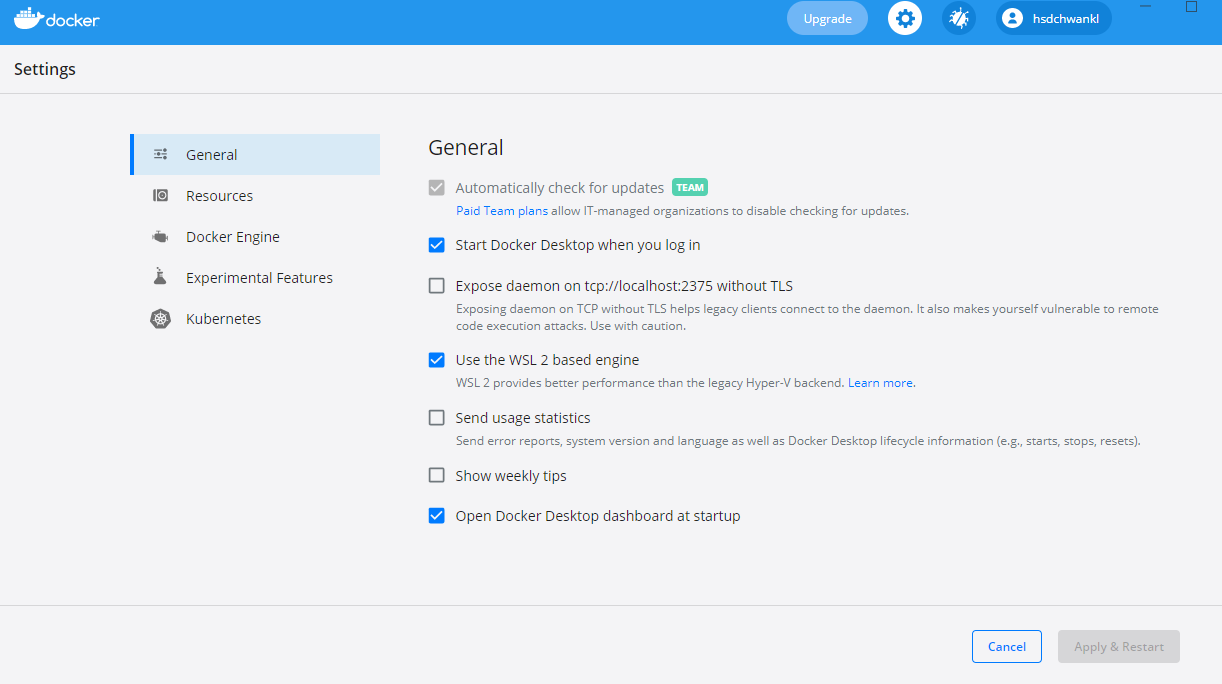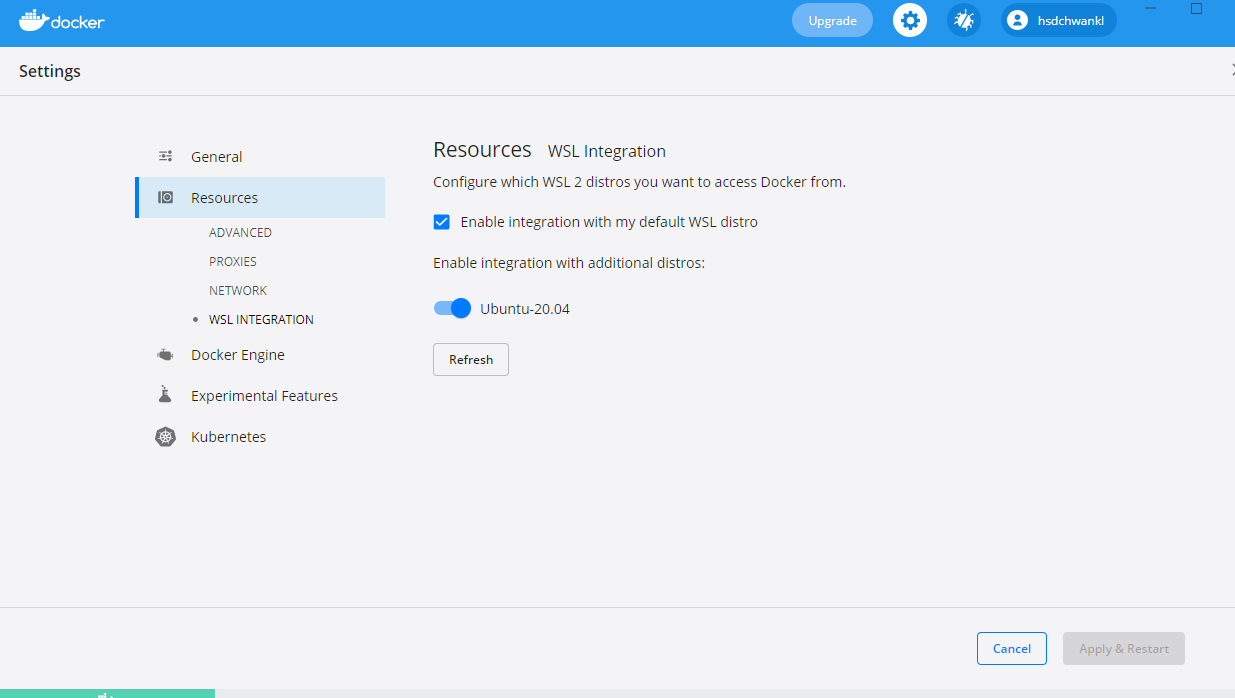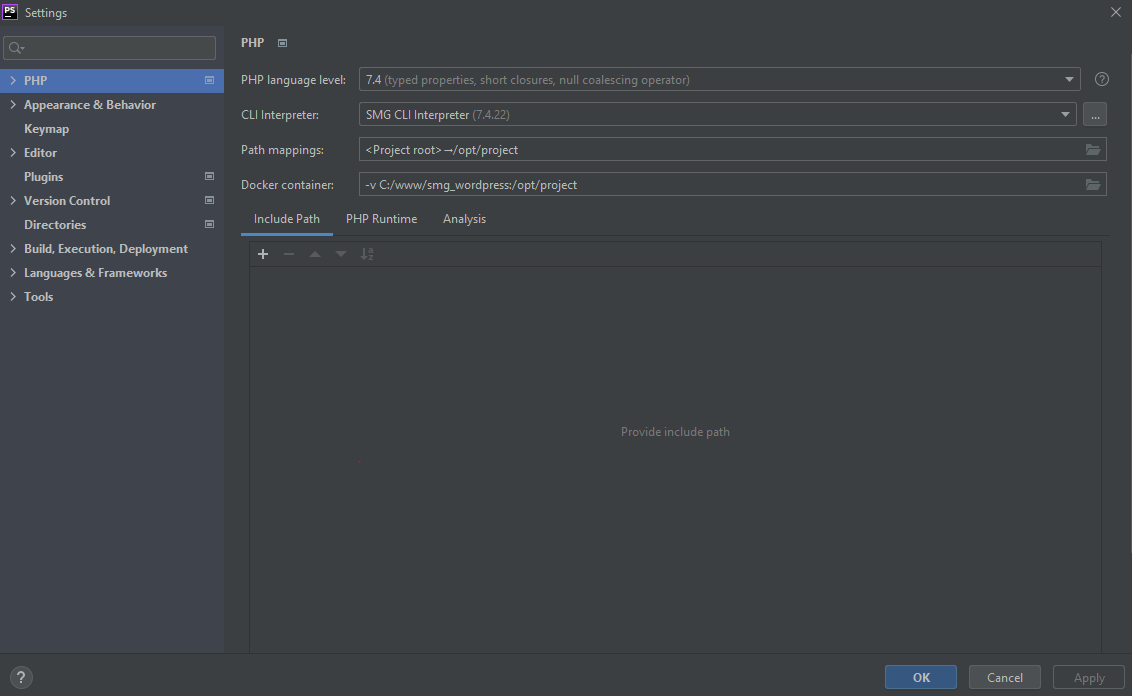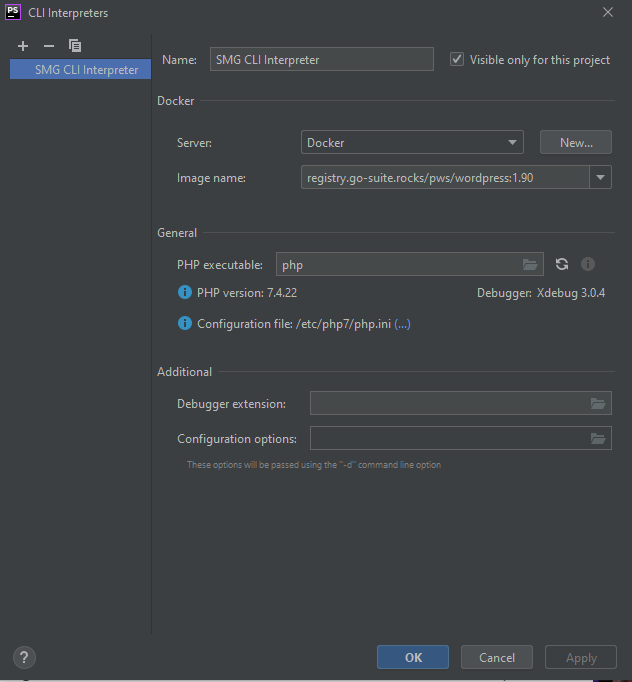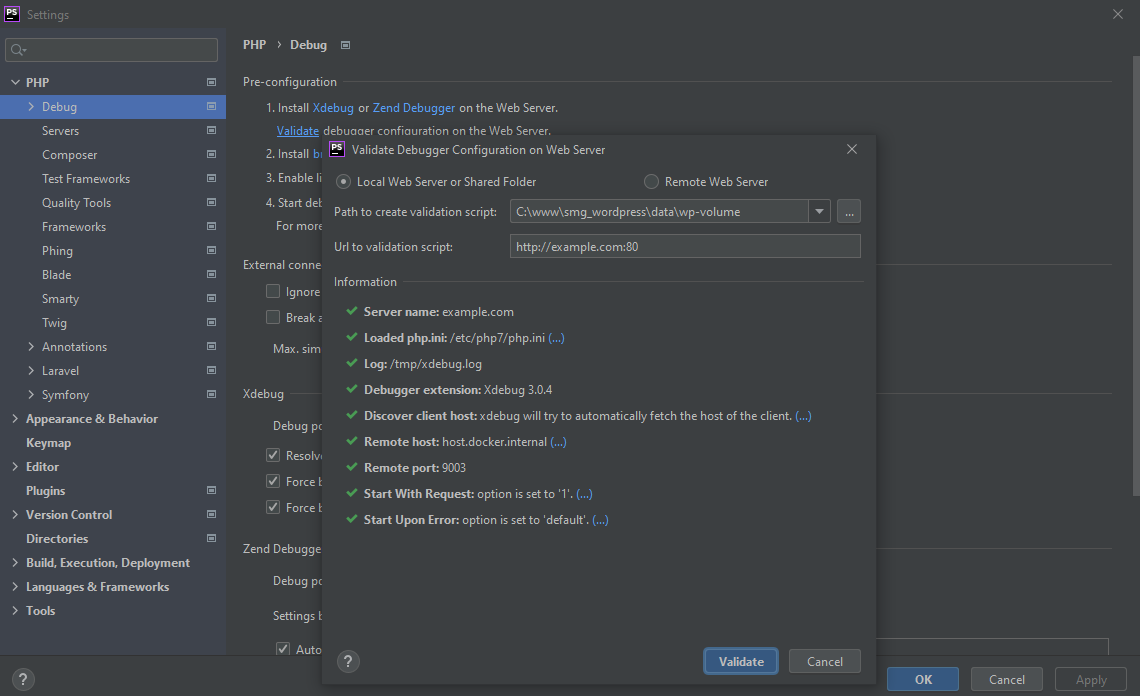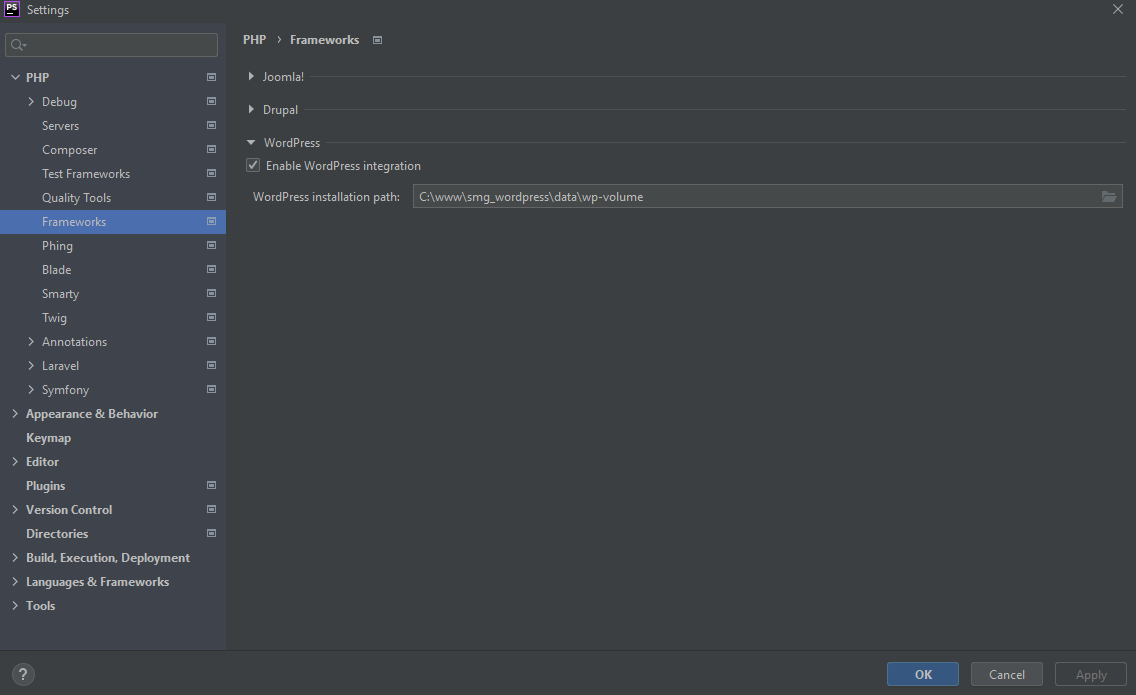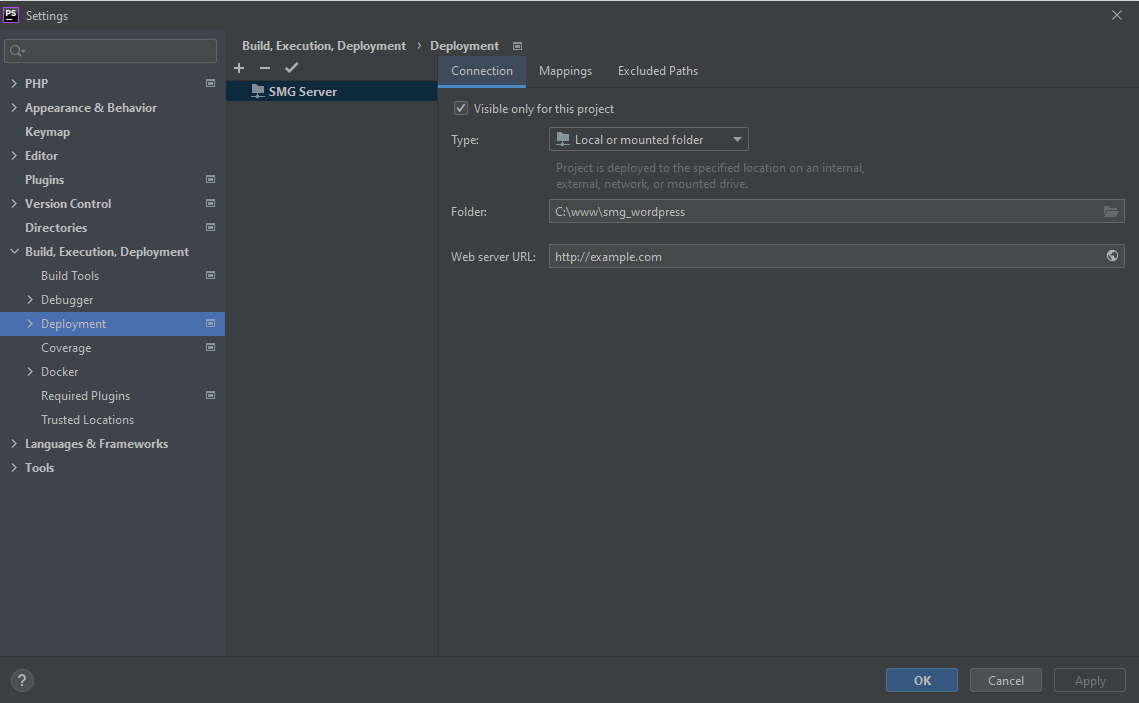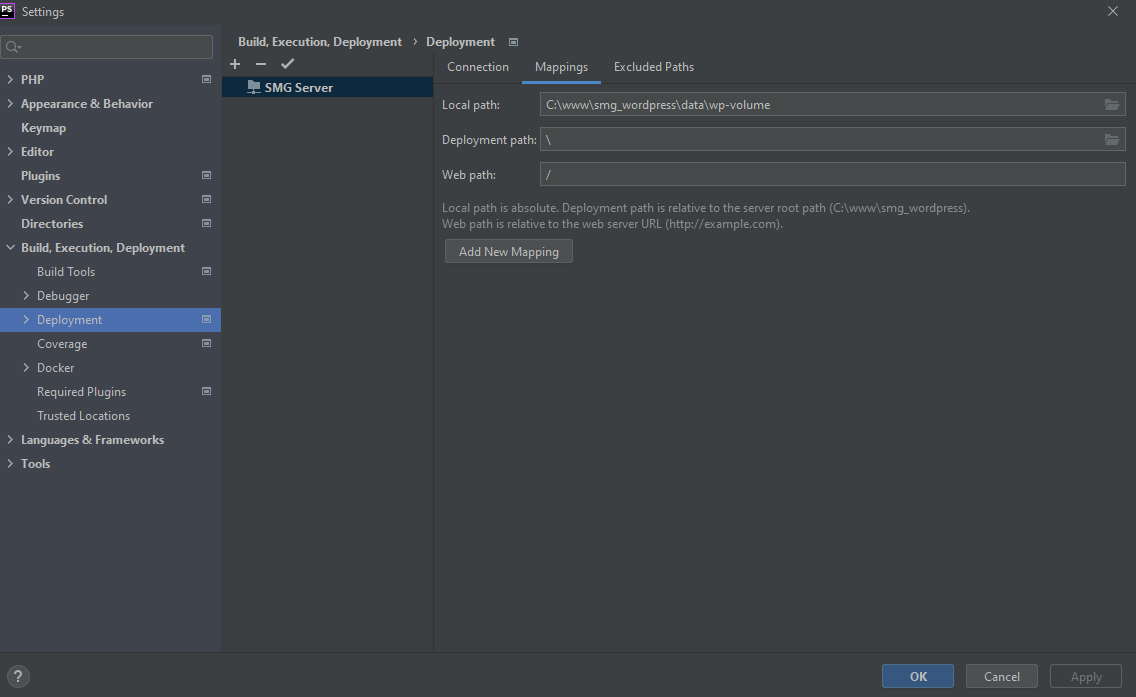This Docker configuration is for Development only.
Integrated functionality:
- For speed up local development environment NGINX caching and gzip compression Todo: ERROR: SSL Failed to load resource: net::ERR_HTTP2_PROTOCOL_ERROR
- Changed to MariaDB Database for Speed improvement
- Improved volumes directive in docker-compose.yml for speed optimization
- Enabled XDebug (https://xdebug.org/docs/)
- XDebug with PHPStorm (https://www.jetbrains.com/help/phpstorm/debugging-with-phpstorm-ultimate-guide.html)
- Enabled Debug on WordPress
- Added "mailhog" for Email testing https://akrabat.com/using-mailhog-via-docker-for-testing-email/
- Added "phpmyadmin" for Database development
- Added Documentation for Development Environment (https://www.markdownguide.org/)
TODO: Deploy a Layout in the local WordPress Configuration
Your Windows computer must meet the following requirements to install successful docker desktop.
- Windows 10 64-Bit: Home, Pro, Enterprise or Education, Version 1903 (Build 18362 or higher).
- Activate the WSL 2-Functionality on Windows.
- The following hardware required to run WSL 2 on Windows 10: For detailed instructions see the Microsoft documentation: https://docs.microsoft.com/en-us/windows/wsl/install-win10.
- 64-Bit-Processor mit Second Level Address Translation (SLAT) https://en.wikipedia.org/wiki/Second_Level_Address_Translation.
- 4GB System RAM
- Support for BIOS-level hardware virtualization must be enabled in the BIOS settings. For more information see Virtualization: https://docs.docker.com/docker-for-windows/troubleshoot/#virtualization-must-be-enabled.
- Download and install the Linux kernel update package: https://docs.microsoft.com/de-de/windows/wsl/install-win10#step-4---download-the-linux-kernel-update-package.
The complete installation instructions can be found at: https://docs.docker.com/docker-for-windows/install/.
Complete installation instructions can be found at: https://konsumschaf.de/post/ubuntu-mit-dem-windows-subsystem-for-linux-wsl-auf-windows-10-installieren/
- Click on Settings in Docker Desktop
- Click on Resources
- Click on WSL Integration
- Enable integration with my default WSL distro
- Activate Ubuntu-20.04
With the terminal command given below the applications are generated and then started the service. You must be in the directory of the project root where the docker-compose.yml file is located.
docker-compose up
docker-compose up -d
If an error has occurred and has made adjustments to the setup, you must execute the following command.
docker-compose up --build
To stop the service, you enter
docker-compose down
For additional Information look at: https://phoenixnap.com/kb/remove-docker-images-containers-networks-volumes
- Set "PHP language level" to 7.4
- Select "CLI Interpreter"
- Set Name to "SMG CLI Interpreter"
- Select "Server" to Docker
- Select "Image name" to registry.go-suite.rocks/pws/wordpress:1.90
- Debugger: Xdebug 30.0.4 must shown
- Click on "Validate" debugger configuration on the Web Server. No error must have shown.
"Cancel" and "Apply"
- WordPress
- Enable WordPress integration
- 'WordPress' installation path: to "wp-volume"
- Select Type "Local or mounted folder"
- Folder -> The folder where docker-compose.yml lays
- Web server URL: "http://example.com"
- Change to Mappings
- Change "Local path" to "wp-volume"
- Select Deployment path
- Change "Web path" to "/"
a) Install "cURL" (a tool for downloading content from the Internet from the command line) with
sudo apt-get install curl.
b) Install "nvm" with
curl -o- https://raw.githubusercontent.com/nvm-sh/nvm/v0.36.0/install.sh | bash
Find the newest version of "nvm" on: https://github.com/nvm-sh/nvm c) To verify the installation, type command
-v nvm
d) nstall the current release of Node.js (to test the latest feature improvements, but which probably contains some bugs):
nvm install node
e) Install the latest stable LTS release of Node.js (recommended):
nvm install --lts
f) List the installed versions of Node on:
nvm ls
g) Use
node --version
to check if Node.js is installed and has the latest version. Then check if you also have npm:
npm --version
(You can also use which node or which npm to display the path used for the default versions.) Now you should list the two versions you just installed. h) To change the version of Node.js that you want to use for a project, create a new project directory
mkdir NodeTest
and switch to the directory (cd NodeTest). Then type
nvm use node
and switch to the current version, or use
nvm use --lts
to switch to the LTS version. You can also use a specific other version that you have installed, e.B.
nvm use v8.2.1
To list all available versions of Node.js, use the
nvm ls-remote
command.
Change node version example for "DIVI" development
node -v
install nvm
nvm use 14.17.4
For additional Information look at: https://docs.microsoft.com/de-de/windows/dev-environment/javascript/nodejs-on-wsl
Used for "DIVI" development.
sudo apt update
sudo apt install yarn
For additional Information look at: https://linuxize.com/post/how-to-install-yarn-on-ubuntu-20-04/
4.1.3 Install "SASS" on Ubuntu (https://sass-lang.com/)
You can install SASS in Ubuntu with two simple commands:
sudo apt-get install ruby-full build-essential rubygems
sudo gem install sass
4.1.4 Install "COMPOSER" on Ubuntu (https://getcomposer.org/)
You can install SASS in Ubuntu with two simple commands:
sudo apt update
sudo apt install php php-cli php-fpm php-json php-pdo php-mysql php-zip php-gd php-mbstring php-curl php-xml php-pear php-bcmath
Now, We are downloading and installing the Composer with the following commands:
cd ~
curl -sS https://getcomposer.org/installer -o composer-setup.php
You need to execute the following PHP code to verify that the Composer installer.
HASH=`curl -sS https://composer.github.io/installer.sig`
If you want to verify the obtained value, you can run:
echo $HASH
Output
e0012edf3e80b6978849f5eff0d4b4e4c79ff1609dd1e613307e16318854d24ae64f26d17af3ef0bf7cfb710ca74755a
Now execute the following PHP code, as provided in the Composer download page, to verify that the installation script is safe to run:
php -r "if (hash_file('SHA384', '/tmp/composer-setup.php') === '$HASH') { echo 'Installer verified'; } else { echo 'Installer corrupt'; unlink('composer-setup.php'); } echo PHP_EOL;"
Run the following command to test your installation:
composer
Output
______
/ ____/___ ____ ___ ____ ____ ________ _____
/ / / __ \/ __ `__ \/ __ \/ __ \/ ___/ _ \/ ___/
/ /___/ /_/ / / / / / / /_/ / /_/ (__ ) __/ /
\____/\____/_/ /_/ /_/ .___/\____/____/\___/_/
/_/
Composer version Composer version 2.2.9 2022-03-15 22:13:37
Usage:
command [options] [arguments]
Options:
-h, --help Display this help message
-q, --quiet Do not output any message
-V, --version Display this application version
--ansi Force ANSI output
--no-ansi Disable ANSI output
-n, --no-interaction Do not ask any interactive question
--profile Display timing and memory usage information
--no-plugins Whether to disable plugins.
-d, --working-dir=WORKING-DIR If specified, use the given directory as working directory.
--no-cache Prevent use of the cache
-v|vv|vvv, --verbose Increase the verbosity of messages: 1 for normal output, 2 for more verbose output and 3 for debug
...
4.1.5 Install "git" on Ubuntu (https://git-scm.com/)
First, use the apt package management tools to update your local package index.
sudo apt update
With the update complete, you can install Git:
sudo apt install git
You can confirm that you have installed Git correctly by running the following command and checking that you receive relevant output.
git --version
4.1.6 Install "gettext" on Ubuntu (https://docs.python.org/3/library/gettext.html)
You can install gettext in Ubuntu with two simple commands:
sudo apt-get update -y
sudo apt-get install -y gettext
4.1.7 Install "node.js" on Ubuntu (https://nodejs.org/de/)
Install Node.js and npm from the Ubuntu repository
sudo apt update
sudo apt install nodejs npm
The command above will install a number of packages, including the tools necessary to compile and install native addons from npm. Once done, verify the installation by running:
sudo apt update
sudo apt install nodejs npm
nodejs --version
4.1.6 Install "WP CLI" on Ubuntu (https://wp-cli.org/)
Before installing WP-CLI, please make sure your environment meets the minimum requirements:
UNIX-like environment (OS X, Linux, FreeBSD, Cygwin); limited support in Windows environment PHP 5.6 or later WordPress 3.7 or later. Versions older than the latest WordPress release may have degraded functionality
Once you’ve verified requirements, download the wp-cli.phar file using wget or curl:
curl -O https://raw.githubusercontent.com/wp-cli/builds/gh-pages/phar/wp-cli.phar
Next, check the Phar file to verify that it’s working:
php wp-cli.phar --info
To use WP-CLI from the command line by typing wp, make the file executable and move it to somewhere in your PATH. For example:
chmod +x wp-cli.phar
sudo mv wp-cli.phar /usr/local/bin/wp
If WP-CLI was installed successfully, you should see something like this when you run wp --info:
$ wp --info
OS: Linux 5.10.60.1-microsoft-standard-WSL2 #1 SMP Wed Aug 25 23:20:18 UTC 2021 x86_64
Shell: /usr/bin/zsh
PHP binary: /usr/bin/php8.1
PHP version: 8.1.0
php.ini used: /etc/php/8.1/cli/php.ini
MySQL binary: /usr/bin/mysql
MySQL version: mysql Ver 8.0.27-0ubuntu0.20.04.1 for Linux on x86_64 ((Ubuntu))
SQL modes:
WP-CLI root dir: /home/wp-cli/
WP-CLI vendor dir: /home/wp-cli/vendor
WP_CLI phar path:
WP-CLI packages dir: /home/wp-cli/.wp-cli/packages/
WP-CLI global config:
WP-CLI project config: /home/wp-cli/wp-cli.yml
WP-CLI version: 2.6.0
Updating
wp cli update
Chang to "plugins" folder : smg-theme-extension
yarn install
For additional Information look at:
- https://www.elegantthemes.com/documentation/developers/divi-development-environment/
- https://www.elegantthemes.com/documentation/developers/create-divi-extension/
- https://github.com/elegantthemes/create-divi-extension
- https://github.com/elegantthemes/divi-extension-example
- https://diviextended.com/how-to-create-custom-divi-module-part-3-understanding-yarn-commands/
- https://www.elegantthemes.com/documentation/developers/how-to-create-a-custom-field-for-a-divi-builder-module/
- https://divi.space/tips-tricks/how-to-use-divis-hooks/
- https://divi.space/blog/adding-custom-modules-to-divi/
A comparison between JSX for React (JS) to Twig
- https://github.com/alexander-schranz/twig-for-react-devs React Documentation
- https://reactjs.org/
Updating CSS files:
a) Changes in the directory ./scss b) compile changes
sass scss:public/css/ --watch
c) deployment
sass scss:public/css/ --watch
rsync -aHv public/css/* root@cache1.sr-ver.de:/srv/www/cdn.sr-vice.de/quadra/wordpress/css/
d) theme testing for example on "99993.quadra-testen.de mit ?scheme=lightblue"
For additional Information look at: https://docs.gitlab.com/ee/topics/git/
Generate SSH key: https://gitlab.go-suite.rocks/help/ssh/README#generate-an-ssh-key-pair
6. Redis (https://redis.io/)
Start Server
redis-server
redis-cli ping
Shows the IP Addresses of the running containers
docker ps -q | xargs -n 1 docker inspect --format '{{range .NetworkSettings.Networks}}{{.IPAddress}}{{end}} {{ .Name }}' | sed 's/ \// /'
Useful Link: https://supporthost.in/install-redis-on-a-plesk-server/
7. Executing WP CLI in Container (https://wp-cli.org/de/)
Example: Activate Theme
docker exec sasom-wordpress wp-cli theme activate eightshift-template
Happy coding :-)
